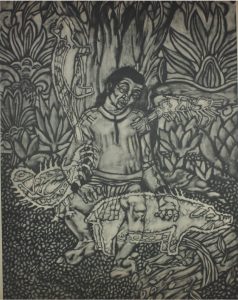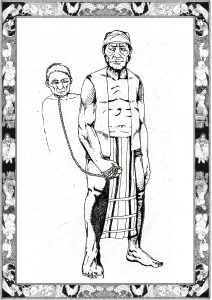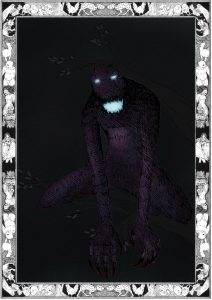Ifugao – ‘Linnawa’
The soul (linnawa) of a child floats around in the heavens, awaiting its entry into the human world. During sexual intercourse the soul/spirit enters the female through the male, resulting in pregnancy. If a woman cannot conceive, shamans conduct sacrifices to see if the couple is compatible. If they are, shamans offer other sacrifices to enhance fertility.
The soul is believed to continue in existence in the world of its ancestors. In time the soul of the new-dead becomes one of the callading or ancestral spirits. The callading are considered man’s benefactors.
In some sources (The Soul Book) the Ifugao believe there are two souls, one in the eyes and one in the breath. Illness is the withdrawal of the soul in the eyes. Death is the withdrawal of the soul in the breath.
Ibaloi
The Ibaloi afterlife is populated by ancestral spirits, and explains animal sacrifices. In that spiritual world, when the soul arrives with physical treasures, it receives a great welcome. An empty-handed soul finds himself the object of scorn. He is unwelcome and unaccepted in his new world and this feeling of insecurity may cause the spirit to bring evil, disease and even death among his relatives. In the light of all those beliefs, relatives of the dead person bring donation of cash or animals.
Isneg – ‘Kaduwa’
The Isneg believed that dead exist in other world, the Aglalanawan, where the earthly tasks of planting, harvesting and communal living are functions common to them. The kaduwa, soul, is believed to cross the pond in a ferry piloted by the spirit, Kutaw(A psychopomp). In a bid to please kutaw, who could facilitate the spirit’s entry to aglalanawan, the appropriate customary death rituals would be the key.
Kankana-ey – ‘Ab-abiik’
Ab-Abiik is the spiritual self as opposed to the physical self (Awak). The Ab-abiik can also apply to inanimate objects such as mountains, trees or rivers. It can also mean ‘inspiration’ in some contexts.
Bikol
No one should miss their dinner and go to bed hungry or their spirit will roam for food. If a pot of food is covered while the spirit is eating inside, the person who is sleeping will now wake up until the lid is lifted.
Tagalog – ‘Kaluluwa and Kakambal’
The Tagalog soul, the kaluluwa can leave the body involuntarily. The kaluluwa refers more to the soul of the deceased. The soul of a living person is called kakambal (meaning twin or double). The kakambal may travel around at night and some particularly bad encounters are the cause of nightmares (bangungut). The kakambal becomes a kaluluwa after death.
Ilokano – ‘Kararua, Karkarma, Aniwaas and Araria’
The first soul of the Ilokanos is called the kararua, or the soul proper. This is the term used for the equivalent of the Christian soul that can only leave after death.
The Ilokano have a four soul system. In addition to the kararua there are three other souls.
Karkarma is the name of the second soul. It can leave the physical body when one is frightened, or may be stolen. If this soul fails to return the owner becomes insane, sacrificial ceremonies may be held to lure back a lost karkarma. Karkarma stands for natural vigor, mind and reason.
Aniwaas is the name of the third soul. It can leave the body during sleep and visits places familiar to the body. If one wakes up while the aniwaas is visiting these places, they may lose the aniwaas and become insane.
Araria is the name of the fourth soul. This is the liberated soul of the dead, the soul that visits relatives and friends in the earthworld asking them to pray for it or perform a duty it failed to do in life. Its presence can be heralded by the howling of dogs. This soul can make sounds and manipulate physical objects usually relating to what it did in life.
Ibanag – ‘Ikaruruwa’
The Ibanag have a distinction between body (baggi) and soul (ikaruruwa). Ikarurua means ‘a companion of the body’. Mekararuanan (me + kararua – to be rid of the soul) is a phenomenon where the soul can leave the body but it is without sense. The ritual Mangagaggako invites the soul to return to the body
The Ibanag believe that the soul has physical characteristics. The soul may have color and the souls of dead babies can reach adulthood in the spirit realm. The role of the soul is to give direction and wholeness to the man, but the body can survive without the soul, and even without the body the soul experiences material wants and needs.
Mangyan – ‘Karaduwa’
The Hanunoo Mangyan believe in a plurality of souls. Karaduwa tawu/tawo (human soul), karaduwa manok (Chicken soul) Karaduwa Baboy (pig soul) karaduwa kuti (cat soul) and karaduwa hipon (shrimp soul). An individual may possess 2-5 other souls. These other souls are explanations for miraculous recoveries from near fatal experiences, their dream life or natural reactions to startling sounds or movement.
A soul can also separate itself from the physical body. If a person is scared, his soul leaves his body causing sickness. When a person dreams the karaduwa walks around. The dream that a person has is caused by this walk.

Bisaya – ‘Dungan’
A soul can be captured by bad spirits (e.g. egkantu). Souls may be imprisoned in a spirit cave guarded by old Tan Mulong whose spirit dog has one mammary gland and two genitals. Sickness is the temporary loss of the soul, permanent loss is death. The soul can be lured back by a skillful shaman. The dungan is ethereal, something not weighed down by the world. Before it inhabits a human body it inhabits a region above the earth with other dungan. The dungan then takes interest in the unborn being, usually a relative which it had chosen to inhabit.
The dungan is not located in any specific part of the body and it grows proportionately with the person’s body. Weak at birth it is vulnerable to usug or the unintentional transfer of disturbing vapors of a strong body to a weak one by proximity. There are many rituals performed to protect and nurture the dungan.
Dungan also has a secondary meaning of willpower. A stronger dungan means that the person has a greater capacity to dominate others to their line of thought. People living together may lead to a spiritual competition between the two dungan leading to the weaker becoming sick.
At death the dungan leaves the body via any of the orifices and goes with the air toward the upper regions. There it waits until it finds another body to enter.

Ilonggo – ‘Dungan’
The Ilonggo soul, the dungan is not seen by the human eye. Sometimes it goes out of the body and takes on visible forms as insects or small animals A dungan may leave the body voluntarily while the person is sleeping. If one sees themselves in their dreams it means their dungan has left their physical body. A slumbering person should be waken gently to give the soul a chance to return to the body. Whatever happens to the dungan also happens to the physical body. The dungan also withdraws from the body if said body is badly treated
Sulod – ‘Umalagad’
Dying among the Sulod is said to be like passing through a narrow door. The experience is horrible, as if the person has to pull hard to get in the door. Once one departs they simply disappear. No trace of them is left behind.
This soul is watched over by three brother gods Mangganghaw, Manglaegas and Patag’aes. Mangganghaw keeps track over man’s affairs immediately after marriage. He keeps track of pregnancy. He is also the first to come to the house of a laboring mother, peeps in the house and sees the child being born, after which he reports to Manglaegas. Manglaegas, after being reported to by Mangganghaw, enters the house to look for the child to make sure the child was born alive, then reports to Patag’aes who waits until midnight then enters the house to have a conversation with the infant. If Patag’aes discovers anyone eavesdropping on their conversation, he chokes the child to death. The conversation is on how long the child wants to live and how the child will eventually die. The child gets to choose. After the child has chosen, Patag’aes takes out his measuring stick and computes the child’s life span, and then he departs.
Tagbanwa – ‘Kiyaraluwa’ and others
A Tagbanwa has one ‘true soul’ the kiyaraluwa and five secondary souls. The kiyaraluwa is given to each infant by the god Magindusa as the nose of the child emerges from the vulva.
The secondary souls are located in the extremities of both hands and feet and in the head just below the air whorl (puyo). The souls of the feet protect one while walking and from injuries to the feet, the same functions to those in the hands. The secondary soul located by the puyo is not fixed in young children and may cause illness if not properly aligned, some shamans specialize in realigning the soul to its proper place. This soul is said to have a material form like a round white stone.
Bukidnon – ‘Makatu’ and ‘Pipitu ha makatu’
The makatu, their world for soul, exists before a child’s birth but it is separate from the body. There is a ritual in which a miniature cradle is hung over the pregnant mother in a place where the mother sleeps. The small cradle is where the soul of the unborn baby will sleep before it joins the infant at birth. The makatu is breathed into man at birth by Miyaw-Biyaw. If all are present in an individual, they are healthy, if one or more wanders away from the body then Illness, irritability and sadness follow. If all makatu leave the body at the same time, the individual dies.
The Bukidnon also believe in seven souls called the ‘pipitu ha makatu’. One jumps off the cliff, one swims in the water, one puts its hand in snake holes, one sits under a tree, one is always walking around, one is awake in the day and one is awake at night.
Bagobo – ‘Gimokud’
There are two souls called gimokud. Right hand gimokud is the good soul that manifests as a shadow on the right hand side of the path while the left hand gimokud is the bad soul that manifests as a shadow on the left side of the path.
The right hand is associated with life, health, activity and joy, remaining in the body throughout life. When death causes the right hand gimokud to leave the body, it gives notice by visiting in the form of an insect.
The left hand soul is the cause of lethargy, pain and illness. The left hand soul also leaves the body at night and risks various dangers, if it visits the sea the sleeping person feels shivers, the behavior it engages in leaves a physical effect on the body. After death the gimokud becomes a busaw (digging up dead bodies).

When the throbbing of the skull cap stops, the soul exits through what used to be the fontanel.
All larger animals have two souls each while smaller birds bees and insects only have one soul. Inanimate objects have a single soul which goes to the underworld so they can serve their owners.
ALSO READ: Stars Through the Eyes of Ancient Filipinos
Sources:
Gaverza, J.K. (2014) The Myths of the Philippines. (Undergraduate Thesis). University of the Philippines Diliman.
Celino, S. (1990) Death and Burial Rituals and Other Practices and Beliefs of the Cordillerans. (Dissertation). University of Baguio.
Demetrio, F. R., & Cordero-Fernando, G. (1991). The Soul Book . Quezon City: GCF Books.
Jocano, F. L. (1968). Sulod Society. Quezon City: U.P. Press.
Nasayao, E. (2010) Bikol Beliefs and Folkways: A Showcase of Tradition.
Jocano, F. L. (1969). Philippine Mythology. Quezon City: Capitol Publishing House Inc.
Gatan, R. M. (1981). Ibanag Indigenous Religious Beliefs . Manila: Centro Escolar University Research and Development Center.
Magos, A. (1986). The Ideological Basis and Social Context of Ma-aram Practice in Kinaray-a Society. Quezon City: University of the Philippines .
Mercado, L. (1991) Soul and Spirit in Filipino Thought. Philippine Studies Vol. 39, No. 3 (Third Quarter 1991), pp. 287-302
Manuel, A. (1982). On the Etymology of the Tagalog Word: Kaluluwa. St. Louis University Research Journal, XIII(4).
Benedict, L. W. (1916). A Study of Bagobo Ceremonial Magic and Myth . Annals of the New York Academy of Sciences, XXV.
Unabia, C. C. (1986). The Bukidnon Batbatonon and Pamuhay: A Socio-Literary Study. Quezon City : UP Press.
Speculative fiction writer. Philippine folklore and heritage researcher.
Author of The Spirits of the Philippine Archipelago.
Currently in the middle of fixing up an encyclopedia of Philippine Mythical creatures.


